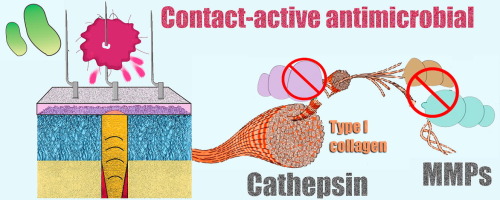Acta Biomaterialia ( IF 9.4 ) Pub Date : 2018-06-06 , DOI: 10.1016/j.actbio.2018.06.008 Ya-ping Gou , Mohamed M. Meghil , Cesar R. Pucci , Lorenzo Breschi , David H. Pashley , Christopher W. Cutler , Li-na Niu , Ji-yao Li , Franklin R. Tay

|
Secondary caries and hybrid layer degradation are two major challenges encountered in long-term resin-dentin bond stability. As a link between resin and dentin, adhesives that possess both antimicrobial and anti-proteolytic activities are in demand for eliminating bacteria-induced secondary caries and preventing hybrid layers from degradation. In the present study, a new quaternary ammonium methacryloxy silane (QAMS) prepared from sol-gel chemistry was incorporated into experimental adhesives to examine their antimicrobial effect and anti-proteolytic potential. This functional methacrylate resin monomer contains polymerizable methacryloxy functionalities as well as a positively-charged quaternary ammonium functionality with a long, lipophilic -C18H37 alkyl chain for puncturing the cell wall/membrane of surface-colonizing organisms. Antibacterial testing performed using agar diffusion test, live/dead bacterial staining and colony-forming unit counts all indicated that the QAMS-containing adhesives killed Streptococcus mutans and Actinomyces naeslundii in a dose-dependent manner via a predominant contact-killing mechanism. Gelatinolytic activity within the hybrid layers created by these adhesives was examined using in-situ zymography. Hybrid layers created with 0% QAMS-containing adhesive exhibited intense green fluorescence emitted by the hydrolyzed fluorescein-conjugated gelatin, with 4-fold increase in enzymatic activity compared with an experimental adhesive containing 5% QAMS. Taken together, incorporation of 5% QAMS in the experimental adhesive provides simultaneous antimicrobial and anti-proteolytic activities that are crucial for the maintenance of long-term resin-dentin bond integrity.
Statement of Significance
Durability of resin-dentin interfacial bond remains a clinically-significant challenge. Secondary caries caused by bacteria and the degradation of hybrid layers via endogenous dentin proteases are two important contributors to the poor resin-dentin bond durability. The present study developed a new 5% QAMS-containing adhesive that provides simultaneous antimicrobial and dentin protease inhibition functions to extend the longevity of resin-dentin bonds.
中文翻译:

使用同时具有抗菌性能和抗蛋白水解活性的生物活性胶来优化树脂-牙本质键的稳定性
次生龋齿和杂化层降解是长期树脂-牙本质键稳定性遇到的两个主要挑战。作为树脂和牙本质之间的联系,需要具有抗菌和抗蛋白水解活性的粘合剂,以消除细菌引起的继发龋齿并防止杂化层降解。在本研究中,将由溶胶-凝胶化学制备的新的甲基丙烯酸甲基丙烯酸季铵盐(QAMS)掺入实验粘合剂中,以检查其抗菌效果和抗蛋白水解潜力。该官能甲基丙烯酸酯树脂单体包含可聚合的甲基丙烯酰氧基官能团以及带长亲脂性-C 18 H 37的带正电荷的季铵官能团用于刺穿表面定殖生物的细胞壁/膜的烷基链。使用琼脂扩散测试,活/死细菌染色和集落形成单位计数进行的抗菌测试均表明,含有QAMS的粘合剂通过主要的接触杀伤机制以剂量依赖的方式杀死了变形链球菌和内生放线菌。使用原位检查了这些粘合剂在杂化层中产生的明胶分解活性酶谱学。与含5%QAMS的实验粘合剂相比,用含0%QAMS的粘合剂产生的杂化层显示出水解的荧光素共轭明胶发出的强烈绿色荧光,酶促活性提高了4倍。两者合计,在实验粘合剂中掺入5%QAMS可同时提供抗微生物和抗蛋白水解活性,这对于维持长期的树脂-牙本质键完整性至关重要。
重要声明
树脂-牙本质界面键的耐久性仍然是临床上的重大挑战。由细菌引起的继发性龋齿和通过内源性牙本质蛋白酶降解杂化层的原因是造成不良的树脂-牙本质键耐久性的两个重要原因。本研究开发了一种新型的含5%QAMS的胶粘剂,该胶粘剂同时具有抗菌和抑制牙本质蛋白酶的功能,以延长树脂-牙本质键的寿命。











































 京公网安备 11010802027423号
京公网安备 11010802027423号